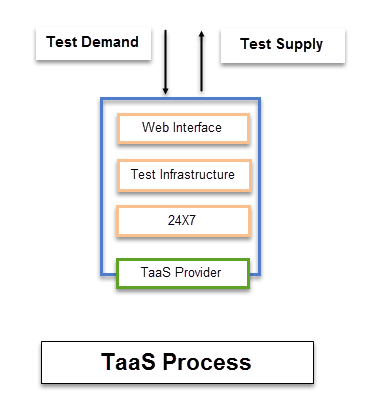
What is TaaS (Testing as a Service): Model, Types, Features
Testing as a Service (TaaS)
TaaS meaning Testing as a Service, is an outsourcing model, in which software testing is carried out by a third party service provider rather than employees of the organization. In TaaS, testing is done by a service provider that specializes in simulating real-world testing environments and finding bugs in the software product.
TaaS is used when
- A company lacks the skills or resources to carry out testing internally
- Don’t want the in-house developers to influence the results of the testing process (which they could if done internally)
- Save on Cost
- Increase the speed of test execution and reduce software development time.

Testing as a Service (What is TaaS)
In this tutorial, you will learn
- Types of TaaS
- Key TaaS Features
- Software Testing as a Service over Cloud
- When to use TaaS
- Benefits of Cloud Testing
- Traditional vs. TaaS services
Types of TaaS

Types of TaaS
- Functional Testing as a Service: TaaS Functional Testing may include UI/GUI Testing, regression, integration and automated User Acceptance Testing (UAT) but not necessary to be part of functional testing
- Performance Testing as a Service: Multiple users are accessing the application at the same time. TaaS mimic as a real-world users environment by creating virtual users and performing the load and stress test
- Security Testing as a Service: TaaS scans the applications and websites for any vulnerability
Key TaaS Features

Key Features of TaaS
Software Testing as a Service over Cloud
Once user scenarios are created, and the test is designed, these service providers deliver servers to generate virtual traffic across the globe.
In Cloud, software testing occurs in following steps
- Develop users scenarios
- Design test cases
- A select cloud service provider
- Set up infrastructure
- Leverage cloud service
- Start testing
- Monitor goals
- Deliver
When to use TaaS
TaaS is useful when
- Testing of applications that require extensive automation and with short test execution cycle.
- Performing a testing task that doesn’t ask for in-depth knowledge of the design or the system
- For ad-hoc or irregular testing activities that require extensive resources.
Benefits of Cloud Testing
- Flexible Test Execution and Test Assets
- Some users claim 40-60% savings in the cloud testing vs. the traditional testing model
- Achieve a fast return of investments by eliminating the investment made after hardware procurement, management, and maintenance, software licensing, etc.
- Deliver product in quicker time through rapid procurement, project set-up, and execution
- Ensure data integrity and anytime anywhere accessibility
- Reduce operational costs, maintenance costs, and investments
- Pay as you use
Traditional vs. TaaS services
| Approach | Traditional | TaaS |
|---|---|---|
| Test Environment |
|
|
| Test Assets |
|
|
| Test Data |
|
|
| Test Tools |
|
|
| Test Documentation |
|
|
| Business Domain Knowledge |
|
|
Summary
- TaaS definition: Testing as a Service (TaaS) is an outsourcing model, in which software testing is carried out by a third party service provider rather than employees of the organization.
- TaaS is used when a company lacks the skills or resources to carry out testing internally.
- Types of TaaS: Functional, Performance, & Security
- TaaS helps achieve a fast return of investments by eliminating the investment made after hardware procurement, management, and maintenance, software licensing, etc.




0 Response to "What is TaaS (Testing as a Service): Model, Types, Features"
Post a Comment